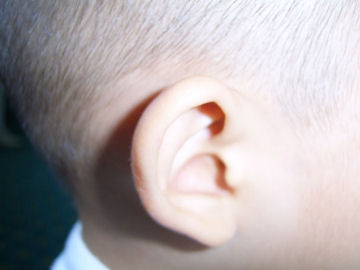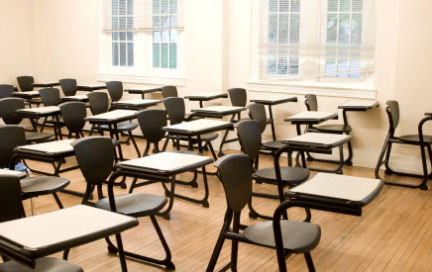Listen and learn
Sound experts give noisy classrooms a failing grade.
By Emily Sohn
If you want to learn anything at school, you need to listen to your teachers. Unfortunately, millions of kids can’t hear what their teachers are saying. And it’s not because these students are goofing off.
Often, it’s the room’s fault. Faulty architecture and building design can create echo-filled classrooms that make hearing difficult.
In recent years, scientists who study sound have been urging schools to reduce background noise, which may include loud air-conditioning units and clanging pipes. They’re also targeting outdoor noises, such as highway traffic.
Experts at the American Speech-Language-Hearing Association have created guidelines that describe how much noise is too much. Although there are no laws to enforce these recommendations yet, a growing number of schools are taking them seriously.
 |
|
Being able to hear the teacher is an important part of learning in school.
|
| iStockphoto.com |
For example, some schools are changing existing classrooms to make them quieter. And new schools are being built with the most advanced noise-eliminating technology available.
Noise reduction is a big deal. Why? Because quieter classrooms might make you smarter by letting you hear your lessons better.
“It’s so obvious that we should have quiet rooms that allow for access to the curriculum,” says Dan Ostergren. He’s an audiologist, or hearing scientist, in Fort Collins, Colo.
“Sometimes it astounds me that we spend so much time discussing this topic,” he adds. “I just want to go, ‘Duh.’ Why is this hard for anyone to grasp?”
Hearing problems
Children with hearing impairments suffer most from noisy classrooms, studies show. They sometimes can’t hear questions that other students ask in class. Compared with kids with healthy hearing, they have a harder time picking up new vocabulary words by overhearing them in conversation.
Tests show that kids with hearing loss have more trouble learning to read than kids who can hear well. They also have a harder time behaving correctly in social situations because they don’t always hear how people normally tell stories or respond to questions. And background noise makes it even harder for them to hear what’s going on.
“It’s a huge problem,” says Peggy Nelson, an audiologist at the University of Minnesota, Twin Cities.
As many as 15 percent of school-age kids in the United States have ear problems that affect their hearing on any given day, according to the Centers for Disease Control and Prevention in Atlanta.
 |
|
Hearing problems can spell trouble for kids in the classroom, but if the room has too much background noise, these kids have even more difficulties.
|
| Wikipedia |
Tests show that even kids with normal hearing have a harder time in the classroom when there’s too much noise. Younger children in particular have trouble separating important sounds—like a teacher’s voice—from background noise, such as the hum of traffic on a nearby highway. That’s because their brains haven’t yet developed the ability to differentiate sounds as well as teenage and adult brains do.
Kids with learning disabilities and speech impediments and kids for whom English is a second language also have a harder time learning in noisy situations.
Taking sound seriously
The American Speech-Language-Hearing Association guidelines recommend that the background noise in classrooms be no higher than 35 decibels (dB). That’s about as loud as a whispering voice 15 feet away. Many classrooms are much louder than that, and, unfortunately, many schools don’t have the resources to correct the problem.
To collect data for the guidelines, Nelson observed schools in a variety of settings—in the city and the country, and in both rich and poor neighborhoods. She used sound meters to measure noise levels in empty classrooms in each of the schools.
Some classrooms registered a peaceful 30 dB. But noise levels in other rooms exceeded 65 dB, almost as loud as a vacuum cleaner.
 |
|
The sounds of roaring traffic, above, and even the hum of computers, below, can contribute to noise in classrooms and make learning more difficult.
|
| Osvaldo Gago/Wikipedia |
 |
| iStockphoto.com |
“A teacher has to shout to be heard above that,” Nelson says.
The noisier a room is to begin with, Nelson says, the louder kids and teachers have to talk to hear each other. So, sound levels just keep going up and up. “It’s kind of a snowball [effect],” she says.
The loud hum of heating and air-conditioning units is the biggest sound problem in many schools, Nelson says. The scraping of chairs on the floor adds noise. So does the background whir of classroom computers and the hum of traffic outdoors.
Keeping it quiet
It costs a lot of money to turn a loud building into a quiet one, but more and more school districts are making sound a priority. And people who are planning new schools are also paying attention to acoustics.
In Fort Collins, Colorado, where Ostergren works, the new Kinard Junior High School has been built with thick, solid walls between classrooms to prevent sounds from leaking through. Sounds create echoes as they ping-pong off hard, parallel surfaces, such as ceilings and floors, so rooms at Kinard have tilted ceilings, to help stop the effect.
Ventilations systems are quiet. Teachers wear microphones, and a built-in speaker system enhances everything they say.
 |
|
One way to reduce noise in the classroom is to put soft pads on the bottoms of desk and chair legs. The cushioning reduces noisy screeches when desks are moved.
|
| iStockphoto.com |
The Kinard School opened in the fall of 2006, and researchers are eagerly awaiting the results of the standardized tests the students took last spring. They hope that test scores will rise when kids can hear more of what’s going on.
“It’s a wonderful long-term study here to see if a school built to the [guidelines] improves student achievement,” Ostergren says.
There is reason to be optimistic. When a major airport changed locations in Germany, Nelson says, students in schools located near the new airport started performing worse on vocabulary and reading tests. Students at schools near the closed airport, on the other hand, started doing better in the same subjects.
Quiet rooms appeal to teachers who don’t like raising their voices to teach. Kids seem to like quieter rooms, too, and not just because they’re learning more.
“When a teacher has to raise her voice, she sounds angry,” Ostergren says. “The general level of ease is enhanced with a better room. Everyone wins.”
Here are some ways to help your teacher make your classroom quieter:
- Put soft pads on the bottoms of chairs and desks.
- Find out if there’s a way to put the ventilation system on a timer so that it doesn’t make a lot of noise during class time.
- Ask the school to fix drafty windows. Where outside air slips through, sounds slip through too.
- Place soundproofing panels on the walls, or use a combination of soft carpets, thick curtains, and cloth wall hangings to absorb sound.
Going Deeper:







